Now that the New Year is here many of us have made the pledge to eat healthier so I thought I would share my favorite, easy to make Pan Seared Salmon recipe.
Salmon filets cooked and ready to eat in only 15 minutes! This is the perfect recipe for those who have busy lives and struggle to eat healthy because of time constraints.
Although it is also a great recipe for those who don’t like to cook but want to save money and improve their diet. It is a simple recipe that requires no special seasonings and no special equipment.
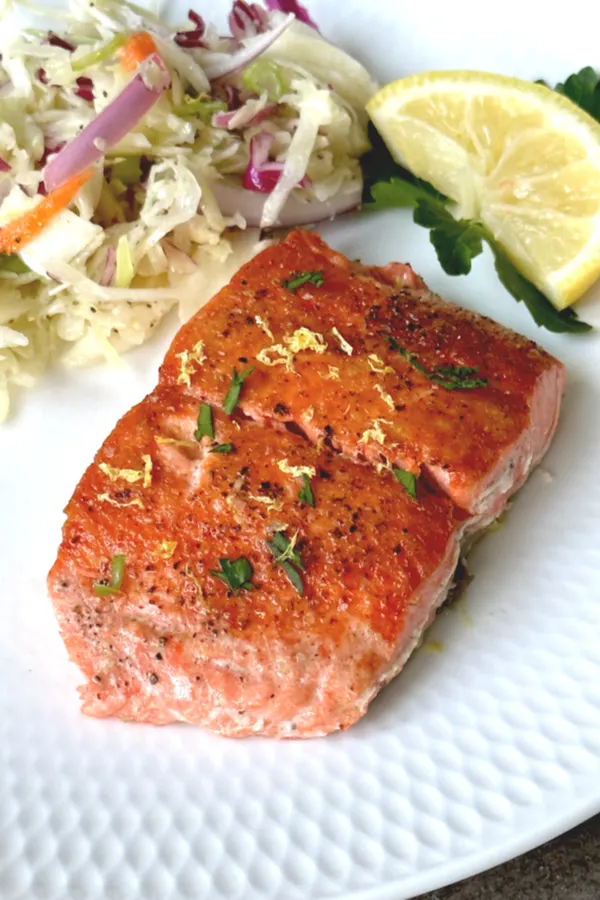
All you need is a skillet, a little oil, salt and pepper, and of course salmon filets. And within minutes you will have light and flaky, perfectly cooked salmon for dinner.
And in this amount of time you can cook Air Fryer Asparagus and a complete and healthy dinner will be ready to serve all at the same time.
Although I could make Sheet Pan Lemon Pepper Salmon & Asparagus, there are times that I need dinner on the table even quicker. Even though salmon cooks relatively fast no matter how it is cooked, by the time the oven preheats the pan seared salmon is almost cooked and ready to be served.
In addition, I love to cook salmon on the stove because I can keep a close eye on how it cooks. Then I know exactly when it is ready to come out of the skillet.
How To Tell When Pan Seared Salmon Is Done
So how do you tell when your salmon is ready? It is actually fairly easy, as salmon will change colors as it cooks.
Salmon will change from a red color to an opaque or light pink color as it cooks. To check for doneness, taking a sharp knife to look into the thickest part of the filet.
If the fish begins to flake, but still has a slight bit of translucency in the middle, it is done. However, it should not look completely red or raw in the middle.
Don’t worry if your filet has a thin end that is done before the thicker middle section. There is more fat in the thinner edges and it will remain moist while the salmon finishes cooking.
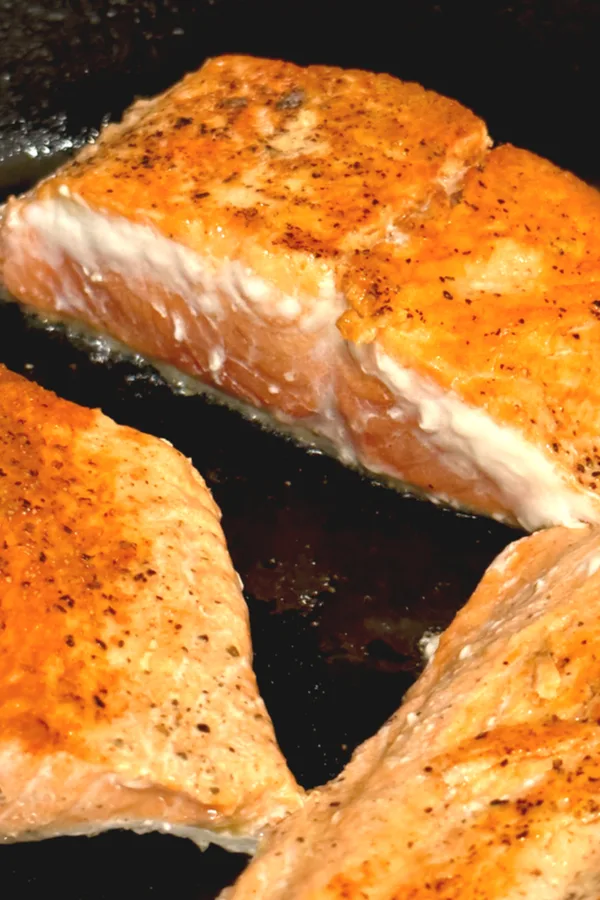
The Butter Knife Method
However there is another method that you can use to check to see if your pan seared salmon is done. It may sound crazy but using a butter knife will help you check for doneness.
Start by inserting a butter knife in the thickest part of the filet. Then remove it and touch it to your bottom lip.
If the knife is warm, the salmon is ready! However if it is only lukewarm, the salmon needs to continue cooking.
It takes a little practice to perfect this method, but it actually works. However, after I remove the filet from the pan, I will still check for doneness by checking the middle of the flesh for color and flakiness.
Internal Temperature For Pan Seared Salmon
However, for those who prefer a more scientific method, you can also check for doneness with an Instant Read Digital Thermometer. Although the USDA recommends you cooking pan seared salmon to an internal temperature of 145°F, many people find that salmon is overdone at this temperature.
Therefore I prefer to take my salmon out of the skillet when the internal temperature reaches between 125-130°F. Then when you remove the filets from the heat they will continue to heat in the center and become perfectly done.
Wild Caught vs. Farm Raised Salmon
However, before you head to the seafood counter to pick out your salmon, you must first decide what type of salmon to purchase.
Although farm raised salmon costs less per pound, I always purchase wild caught salmon. Wild caught salmon contains fewer calories and fat when compared to farm raised salmon.
They are much leaner than farmed fish because they are constantly on the move in the search for food. Not to mention, there are far less contaminants in the fish itself.
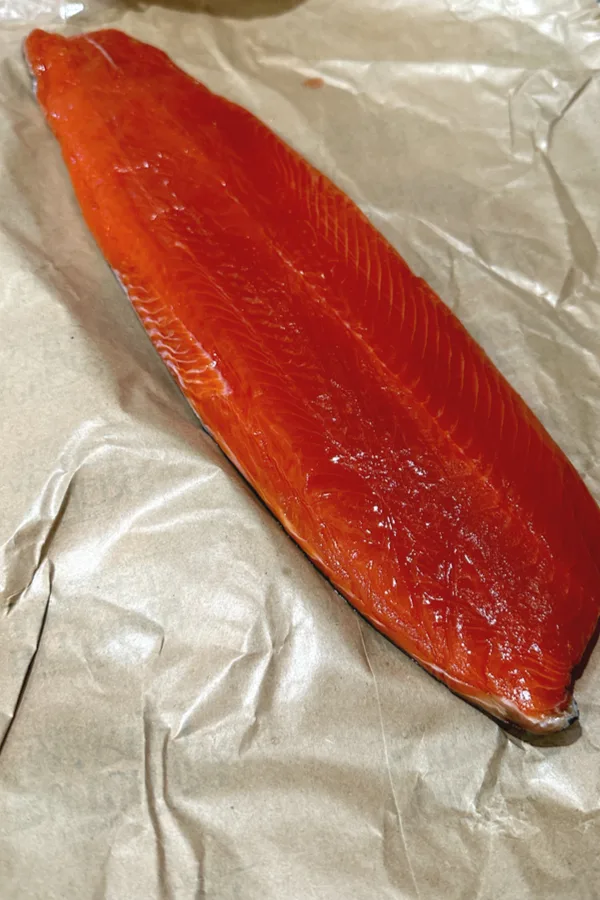
Therefore, the actual flavor of the fish tastes much better. And when you compare the two you can actually visually see the difference between the two types of fish.
Pacific wild caught salmon will have a deep pink, almost red in color. While farm raised salmon will be pale pink in comparison.
Therefore, when you are trying to figure out which is the best type of salmon to purchase opt for wild caught whenever possible.
Fresh vs. Frozen
Now that you know that wild caught salmon is the best choice to make pan seared salmon, now you have to determine if it is best to purchase it fresh or frozen.
If you live on the coast and can purchase salmon that was caught that same day, do so! However, most of us will have to resort to going to a grocery store to purchase salmon.
In that case, it is actually best to purchase frozen salmon filets. Although this may shock you because you will see beautiful salmon filets displayed at the seafood counter.
However, in most instances those large filets have been previously frozen. In order to get the best quality fish it is best to ask the butcher when the filets were thawed.
Although you can also purchase frozen filets in the freezer section. These filets are likely to have been flash frozen as soon as they were processed.
This means that the quality of the fish is just the same as when purchasing just caught fish. So now that you know what type of fish to purchase, it is time to get your pan seared salmon cooking!
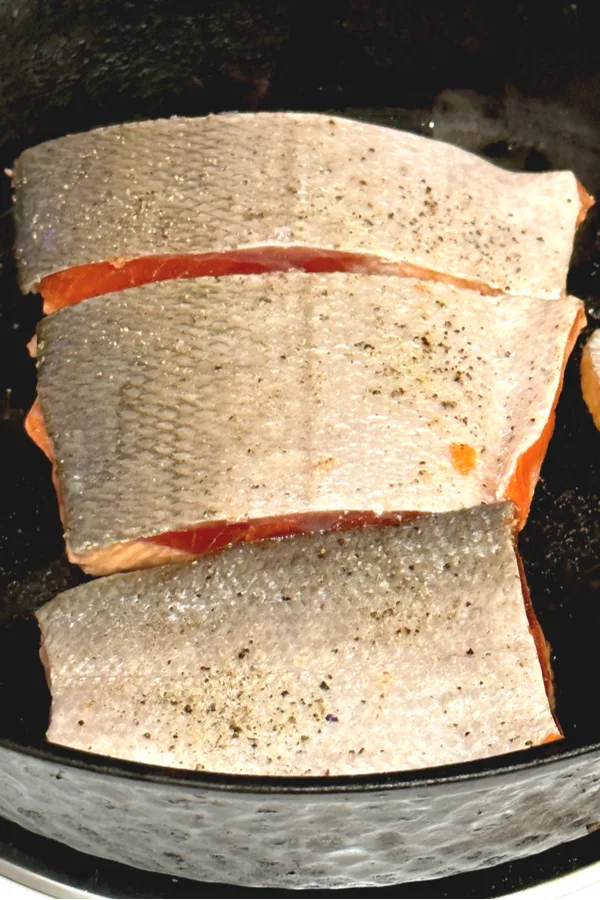
Pan Seared Salmon Recipe
*Specific measurements and complete recipe instructions are located in a printable recipe card at the bottom of this article. However, be sure to continue to read the tips and tricks to making this recipe below.
INGREDIENTS
- 1 tablespoon extra-virgin olive oil
- ½ teaspoon Kosher salt
- Freshly ground black pepper
- 4 (6-ounce) salmon fillets, approximately 1 – 1 1/2 inches thick
INSTRUCTIONS
Start by bringing your salmon filets to room temperature. This is a crucial step so that the extreme temperature differences doesn’t shock the meat.
When you are ready to cook the salmon season both sides of the filets with salt and pepper. Then set the filets aside while you heat up the skillet.
Pour the extra virgin olive oil in a large nonstick skillet and place over medium-high heat. Once the oil is hot and shimmering place the salmon skin side up in the pan.
Cook for 3-4 minutes or until the surface that is face down turns golden brown in color. Carefully flip the each salmon filet over and reduce the heat to medium.

Continue cooking until the pan seared salmon is light and flaky in the center, approximately 4-5 additional minutes more.
Serve warm with a lemon wedge if desired. Yes, it is that easy!
Enjoy! Mary

To receive our 3 Recipe Articles in your inbox each week, sign up for our free email list located in the middle of each recipe or email me at contact@makeyourmeals.com. You can also follow us on Facebook and Pinterest. This article may contain affiliate links where a small commission is paid if you purchase a product at no additional cost to you.
Easy Pan Seared Salmon
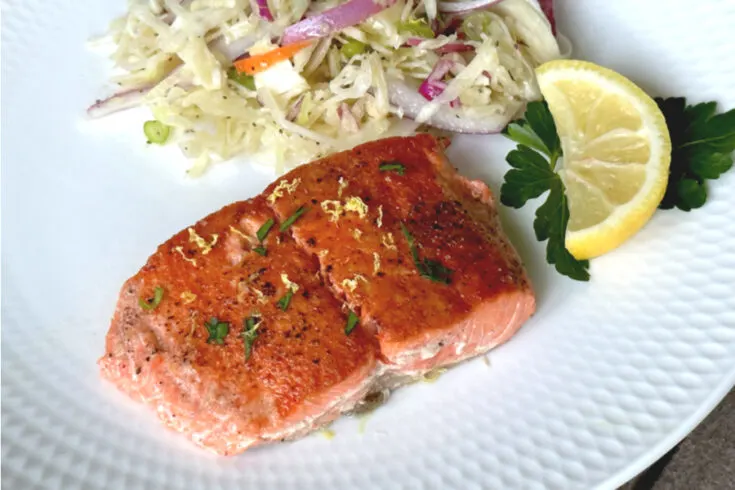
Ingredients
- 1 tablespoon extra-virgin olive oil
- ½ teaspoon kosher salt
- Freshly ground black pepper
- 4 (6-ounce) salmon fillets, 1¼ in thick
Instructions
- Season both sides of each salmon piece salt and pepper. Set aside.
- Add the extra virgin olive oil to a large nonstick skillet and place over medium-high heat. Once the oil is hot and shimmering place the salmon skin side up in the pan.
- Cook for 3-4 minutes, or until the top turns golden brown in color.
- Carefully flip the each salmon filet and reduce the heat to medium. Continue cooking until light and flaky in the center, approximately 4-5 additional minutes more.
- Serve warm.
